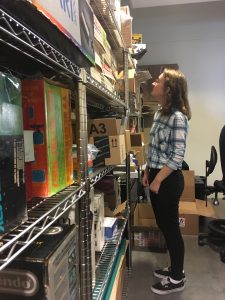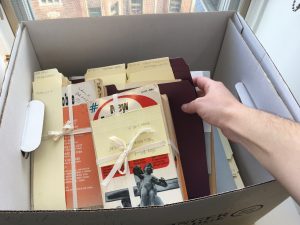Box Anxiety: Collections and the Things that Contain Them/Us
Elizabeth Yakel states that “[a]rchivists are in the container business” (140), a claim I find highly relevant to the Residual Media Depot (RMD) and the Mordecai Richler Reading Room, two Concordia research collections [1] that contain a significant number of items in boxes. Yakel classifies archival boxes as “physical” containers, contrasting them with “intellectual” containers such as policies (140-41). In the case of boxes in the RMD and Richler Room, however, such a clear separation between physical and intellectual may be counterproductive. To understand what working with boxes (and the collections or “container businesses” they constitute) really means, we need to consider how they contain (and constrain?) things—and not just things but also us—both physically and intellectually.
In collections as elsewhere, we often ignore boxes in favour of their contents. This is what Jussi Parikka calls
“the fate of media that become too effective in what they do. They vanish from view, do their job of mediating, and leave the illusion that all there is is content passing through the channels” (“Archive Dynamics” 113).
Thinking of the box as a medium opens it up to other theories from media studies/media archaeology, notably the idea Parikka draws from Friedrich Kittler that technical media “impose new regimes of sensation and use to which we have to accommodate ourselves in order to be functioning subjects”; when we use media, they exercise agency/power over us that influence our own agency (“Media Theory” 70). These concepts reveal that that when we dig through a box to find an item, we are not just engaging with that item—we are engaging with the box, which has an effect on us whether we acknowledge it or not.
For me, effects of the box were especially apparent in the RMD, which focuses on early video game consoles. Its boxes of gaming equipment intimidated me, bringing up daunting questions: would it be okay to touch the boxes, move them, open them? What if I opened them only to break something or put it back in the wrong place?
At first I attributed this “box anxiety” to my lack of experience handling video games. But when I visited the Richler Room’s collection of possessions from Richler’s personal library, I felt similarly uneasy, although most of the items in its boxes (books, papers, writing tools, etc.) were much more familiar. I worried that my digging through boxes, as gentle as I tried to keep it, might displace or damage something. I had a sense that objects like books on the Room’s shelves or the controller just sitting on a desk in the RMD were safer and more accessible. They were already out in the open, welcoming examination. But the objects in boxes made it my responsibility to bring them into the open—they demanded my initiative, my physical action, my culpability if something went wrong.
No doubt there are cultural roots to this anxiety. As children, we are taught to be careful with old or potentially fragile objects and punished if we carelessly damage them. But we cannot fully shift the blame from the box to culture; indeed the two cannot be separated. In the “articulation and assemblage” model as described by Jennifer Daryl Slack and J. Macgregor Wise, culture consists of many “intermingling elements” or “articulations” that come together in ever-changing “assemblages” (112-13). When examining technology’s role in cultural change, this model allows us to see technologies (I here extend the idea to cover things like boxes) as articulations in a “complex cultural assemblage” which in the tensions between its articulations produces many “uses and effects” on many sides—the intimate, messy mingling of culture and technology in this assemblage makes it impossible to blame just one or the other (113).
This means that any cultural influences we speak of may also have/be influences of the box. Boxes are containers with walls, and sometimes covers/lids, that keep things in and/or out. Through their physical form, boxes themselves enforce an insider/outsider structure: when you approach a box, you are an outsider to its contents. As a layer, a shield, between you and what it contains, the box calls for a perhaps small but often discomfiting act of aggression, of breaking through. In this way, to return to Parikka, the box imposes on us its own “regime of sensation and use.”
Thus we may begin to develop something of an explanation, both physical and intellectual, for my box anxiety—not necessarily in order to get rid of it, as such side effects of encountering objects merit further investigation rather than dismissal, but to help us understand what we do to the “container business” of collections and what it does to us.
[1] Archives are not necessarily the same as collections, as Darren Wershler notes when he defines the RMD as a collection, not an archive. I still find Yakel’s statement applicable, however, as the concepts are related and both often involve containers (and Wershler acknowledges that the RMD possesses some archival traits).
Works Cited
Parikka, Jussi. “Archive Dynamics: Software Culture and Digital Heritage.” What is Media Archaeology? Polity Press, 2012, pp. 113-35.
—. “Media Theory and New Materialism.” What is Media Archaeology? Polity Press, 2012, pp. 63-90.
Slack, Jennifer Daryl, and J. Macgregor Wise. Culture and Technology: A Primer. Peter Lang, 2005.
Wershler, Darren. “What’s in a Name?” Residual Media Depot, 21 July 2016, http://residualmedia.net/whats-in-a-name/. Accessed 8 Oct. 2017.
Yakel, Elizabeth. “Thinking Inside and Outside the Boxes: Archival Reference Services at the
Turn of the Century.” Archivaria, vol. 49, 2000, pp. 140-60, https://archivaria.ca/index.php/archivaria/article/view/12742/13927. Accessed 8 Oct. 2017.




